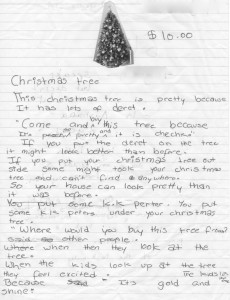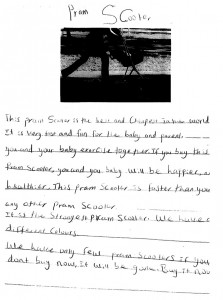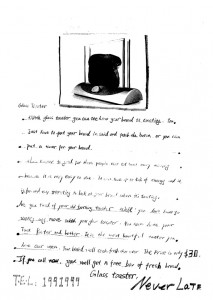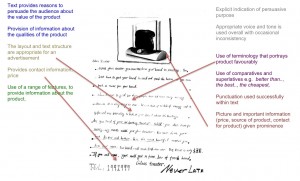14. Writing an advertisement
Please click on the toggles below to navigate through information on this assessment task and reveal the links for downloading task materials.
Task details |
|
| Name of writing assessment task | Writing an advertisement |
| EAL curriculum level range | B2, B3, C2, C3, C4 |
| Text orientation | Persuasive |
| Task type | Cued response/extended response |
Task specification |
|
| Purpose | To assess students’ ability to write a text for an advert and to use language persuasively. |
| Description | Students write a text to advertise their new product. A picture of the product is given to the students. See the appendix for ideas. (These are examples only and can be changed to suit the needs and interests of the students.) |
| Assumed knowledge and description |
|
Learning/teaching context |
|
| Language centre/mainstream class | Small group |
| Subject/key curriculum objectives, outcomes | English |
| Topic/teaching unit | Advertising |
| Assessment conditions |
|
| Notes |
|
Task implementation |
|
| STAGE | ACTION STEPS |
| Pre-assessment activity |
|
| Assessment activity |
|
| Post-assessment activity |
|
- TEAL Writing Task 14 – unmarked criteria sheet [PDF]
- TEAL Writing Task 14 – unmarked criteria sheet [Word]
An explanation of the purpose, nature and use of criteria sheets is available at 4. Using the assessment criteria.
Nature and purpose of the task
This task provides an authentic context for the use of persuasive language, and is also a good way to introduce the concepts of purpose and audience of a text, as both can be clearly demonstrated for this type of text.
This task relates to TEAL Oral Task 20: A sales talk in which students present a spoken presentation of a product in an attempt to convince the audience to buy the product. Both tasks involve types of advertisement, and very explicitly persuasive language.
Written advertisements can be sophisticated texts that use a variety of techniques to achieve their purpose. While provision of information is part of the text, written advertisements also usually try to present the product in a favourable way, by making it appear desirable or appealing in some way. Advertisements are often very short texts, with limited language used in conjunction with an image or a logo. Some information may be provided, but longer advertising texts can have limited impact on readers, and not succeed in holding their attention. Written advertisements may contain some text, but will try to minimise extraneous information and language, reducing the text to phrases, often using common expressions, as well as a range of conventional sales expressions such as The best money can buy! and language related to sales techniques such as Buy one, get one free!, or expressions about the integrity of the advertiser.
The success of EAL learners in producing such texts is likely to be related to the extent to which they have been made aware of such techniques, and their ability to use English in such texts. Early attempts are more likely to focus on provision of information. As students move closer to mainstream contexts of language use, the ability to produce more evocative advertising texts, using cultural reference and nuance to create impressions about a product rather than providing information, may start to develop. In this context, greater language competence is required to produce shorter texts, which is a reverse of the more usual situations where EAL learners at lower levels of proficiency produce shorter texts, and more proficient students usually produce more extensive texts.
Contextual information
The students who produced these samples were at lower stages of EAL proficiency. Consequently, the samples demonstrate different performances at lower levels of performance of the task, and none illustrate the capacities of students at the highest levels of task performance. Nevertheless, they represent a range of different levels of performance of the task, as can be expected from EAL learners making progress in their learning of English.
Teacher support
Sample 1 was produced at relatively short notice as an activity in a single class. The teacher presented the task instructions and used the TEAL task sheet, to provide guidance and discuss ideas with the student. However, this was not done in the context of a unit of work.
The class that produced Samples 2, 3 and 4, was in a new arrivals centre, and had a literacy focus, as many of the students had interrupted schooling. The teacher gave the TEAL task sheet (see Task implementation section) that provides four headings to guide the writing task:
- Name the product.
- Write a caption for the picture.
- Describe the product and how it works.
- Say what makes it special.
- Write a paragraph to persuade people to buy it.
Students practised imperative and superlatives to support the persuasive language of the advertisement.
Commentary
The text has limited success as an advertisement. The layout is consistent with the format provided and the description has a basic relevance, for example, it’s pretty with lots of deret (decorations?) and several reasons are given for buying the tree. However the information is often repetitive and at times not directly relevant to the purpose of the text, for instance, someone might took [sic] your Christmas tree if you put it outside.
A strength of the text is the range of persuasive language features e.g. imperatives, conditional sentences Modality is used, though inappropriately for an advertisement, for example, can look pretty. Similarly, complex sentences are used with varied success to construct an argument. There are some basic grammatical errors.
A few basic conjunctions such as because and so support cohesion within sentences and pronoun reference is used quite well. But linking between sentences is disjointed at times. Repetition and poor organisation impede coherence.
The tone is suitably informal and encouraging such as use of “you” throughout and an exclamation mark.
A key weakness is a limited vocabulary range that detracts from the text. A few terms like excited and pretty work well, but spelling mistakes or errors of word formation are intrusive, for instance, deret (decorations), chechk for cheap, peters for presents, and shine for shiny. However, they indicate the student is attempting to spell unknown words, which is a success-oriented strategy.
The marked criteria sheet shows the text meets most criteria at Level 1 of performance and some at Level 2.
The student’s language use in this task is consistent with the descriptions of Level B2, Victorian Curriculum F-10 EAL.
Using this assessment for further learning
- Modality
The student is ready for a focus on modality as they are using modal expressions but not appropriately.
• Ask the student to look at the table below.
might happen, may happen, will happen, won’t happen, could happen, can happen
Write the words, might, can, may, won’t, will, could in the centre column in a position to indicate show the chance of something happening, for instance, if it is 100%, write will at the top of the column.
|
100% likely
50% likely
0% likely |
happen |
• Ask the students to choose which sentence will best persuade someone to buy the tree.
Ask them to say why they chose their answer. Ask them to focus on the words in italics.
- If you buy this tree for Christmas your children might be very happy.
- If you buy this tree for Christmas your children will be very happy.
- Buying this tree could save you money.
- Buying this tree can save you money.
- This tree can last for many weeks before it looks old.
- This tree will last for many weeks before it looks old.
- Text layout
Discuss the purpose of the text: to attract and persuade customers. Use the board to represent an A4 page and brainstorm ways to lay out the text. Ask students to indicate:
- where to place the tree (or a new product) in the picture and where to place the text
- the most suitable font size
- use of headings or subheadings
- the use of colour
- the length of sentences or sentence fragments
- possible ways to first engage the reader e.g. with a question.
- Repetition
Repetition in this text is likely due to a limited vocabulary and perhaps a concern that ‘more is better’. It suggests the student lacks a range of vocabulary for the task, and so is worthy of attention.
- Discuss the nature of an advertisement with the student and the importance of being catchy and not too long.
- Give the student a highlighter and ask if they can find words and groups of words they can trim from the text. Suggest the student look at words that say the same (or similar) thing again in this case the word pretty and attendant words could be highlighted.
- Ask the student to count the words removed in this way.
- Look at the reduced text and see what it now needs to become a new draft. If the student needs to add new information suggest they use questions words e.g. where, when, who why to evoke new ideas.
- Ask the student to write a revised shorter text, without repetitions.
Commentary
Illustration and headings have been used to make the text attractive and interesting. Features of a print advertisement, positive-sounding adjectives, such as beautiful, a website and an inducement for the first 100 buyers have been included in the text.
The text is brief, and some persuasive techniques are used, such as superlative (the most beautiful) and a statement about how your life will be better. The student has successfully used an imperative and conditional, though the argument is basic ‘your life will be easier’. A superlative is attempted but is overambitious. The use of the adverb only is sophisticated in juxtaposition with the price. Reference pronouns such as. using it and this help unite the text
The voice and tone of the text are friendly, through the use of you and encouraging let’s go to the rain.
This text is basically successful as an advertisement. The persuasive elements are consistent with some successful strategies but the text also includes some unconvincing arguments.
The marked criteria sheet shows the text meets most criteria at Level 2 of performance.
The student’s language use in this task is consistent with the descriptions of Level C2, Victorian Curriculum F-10 EAL.
Using this assessment for further learning
- Use of the when we know which one we are talking about
Explain to the student (s) that we use the in front of a noun when we know which one we are talking about. For example:
A. ‘Give me a book’ (any book). But ‘give me the book near the window.‘ (We know which one.)
B. ‘Look at the moon.’ There’s only one moon so we know which one we are talking about.
C. ‘I saw a dog.’ (any dog). ‘I gave the dog a bone.’ Not any dog but the dog I saw.
D. In the same way we say ‘I saw a big umbrella.’ But we must say ‘I saw the biggest umbrella in the world.’ There is only one biggest in the world.
Exercise Put a or the in the spaces below
(i) I need ………drink, I’m thirsty
(ii) Close ………….door please.
(iii) My brother is …………………oldest child in our family.
(iii) I bought …………..piece of art and when I gave …………………. artwork to my girlfriend she was very happy.
- Making arguments stronger
The student has shown a good feel for advertising strategies, for example, let’s go to the rain so is now ready to argue more forcefully.
Discuss with the student (s) the purpose of persuasion i.e. to make someone do or think what you want them to. It helps if the claims made in an advertisement are at least partly believable. The most beautiful umbrella in the world is not very convincing.
Which of the following claims would make the customer want to buy the umbrella the most? Put them in order from strongest to weakest. Encourage discussion.
This umbrella is:
- The most beautiful umbrella you have ever seen.
- The strongest umbrella in Australia.
- The cheapest umbrella you can buy.
- (continued)
If you buy this umbrella your life will be easier. This is a better argument but saying an umbrella can make your life easier life is still too big. It needs to be made more directly important to the audience. For example, a stronger argument would be you won’t get wet again.
Which of the following arguments is stronger?
- If you buy this umbrella you can keep people dry.
- If you buy this umbrella you can keep yourself/your girlfriend/boyfriend dry.
Commentary
The text successfully fulfills the task to create an advertisement, and presents the product as attractive for the audience, although it is lengthy. The visual is adequate and the organisation is basic but clear.
Cohesion is basic with a few strategies, for instance, reference is used occasionally: This pram scooter and the if clauses help link ideas together. Use of advertising jargon, Buy it now on last line adds an explicit persuasive element to the information provided.
The text uses a range of persuasive language, for example, comparatives, conditionals, imperatives, adverbs (only). The key strength of the text is the convincing arguments constructed using the student’s language skill such as – if you don’t buy now …- faster than any other pram scooter. . you and you(r) baby will be happier and healthier. Vocabulary is basic but sufficient for the task, for instance, cheapest, faster, strongest, buy, with a few misspellings e.g. exarcise. for exercise.
The tone is suitably informal and personal, using you, and the well targeted arguments help to form a connection to the customer. The use of we positions the student as the seller.
The marked criteria sheet shows how the student meets most criteria at Level 3 of performance of the task
The student’s language use in this task is consistent with the descriptions of students at Level C3, Victorian Curriculum F-10 EAL.
Using this assessment for further learning
- Use of exclamation marks for emphasis.
Point out to student(s) that once you use a personal voice such as you it means you are talking to someone as if they are standing beside you. So it is more like speaking than writing and you can use punctuation to help show that. One example is the use of punctuation such as exclamation marks to add emphasis. Model a few examples on the board to show how punctuation can liven up a personal voice and then set the following activity.
How would you read aloud the following?
- Buy it now.
- Buy it now!
- If you don’t buy it now it will be gone.
- If you don’t buy it NOW it will be gone! etc.
- Rhetorical questions
Another way to engage the reader is with a rhetorical question. Point out to student(s) that a rhetorical question does not want an answer. It is a very powerful ‘hook’ to get the reader’s attention and create a need for your product or argument.
Look at the following rhetorical questions. Which one is the best for your advertisement. Why? Which one is the weakest? Why?
- Would you like to buy a new pram? Well here is one you can buy!
- Is your baby keeping you from doing the active and fun things in your life? Well here is an answer for you and your baby!
- Do you want the best for your baby? Well here is an answer for you and your baby!
- Context and text organisation
Point out how the linear layout and organisation of the text may not give the reader ready access to the most important information.
Discuss the likely context for the poster, for example, is it on a wall in a corridor or in a shop window?
- Discuss the context in which a reader might see it.
- Bring in or show from the Internet examples of different poster layouts.
- Provide students with A3 paper scissors and glue. As a second draft ask students in pairs to experiment with ways to reorganise their text and visuals on the page to effectively engage and persuade a passer by.
- Consider the use of headings subheadings and colours and font sizes always with the purpose and context and audience of the poster in mind.
Commentary
The text is persuasive through the extensive information about the claimed advantages of the product. However, the length of the text and the basic layout limit the impact of the text. Font changes are used to effectively highlight key information.
While cohesion within the text is good between sentences such as using pronoun reference with it the format of the text is confusing. At first glance, it appears that dot points are being used to highlight each point, but closer examination shows these are used to mark new lines, rather than new points.
Despite its length, sophisticated control of complex sentences provides a high level of fluency in the text, and the use of you established a personal tone to the text that assists its persuasive purpose.
A range of vocabulary is evident such as just have to, timer, old boring toaster, up to 30% energy including extensive use of adjectives and adverbs. However, spelling errors such as insaid for inside, interesting for interesting, moning for morning and well for will are distracting.
The strength of the text lies in the effective arguments presented with a range of well controlled language features, such as complex sentences like good for those people who …, and intersting to look at your bread when it’s toasting.
The marked criteria sheet shows how the student meets most criteria at Level 3 of performance
The student’s language use in this task is consistent with the descriptions of students at Level C3, Victorian Curriculum F-10 EAL.
Using this assessment for further learning
- Text organisation
Point out how the layout and formatting of this text is a weakness that detracts from its other qualities.
- Provide A3 copies of the students’ advertisement texts. Ask students in pairs to try to reorder their two texts more effectively by cutting out sentences or groups of sentences as required. Provide hints such as What is the role of a rhetorical question? Where could it be used most effectively?
- Ask students to discard or cross out any sentences or sentence parts that are unnecessarily repetitive.
- Once a new order is established discuss if any additional links need to be made between the sections of the text.
- Each student then rewrites their redesigned text.
- Spelling
- Point out that handwritten assessments are common in secondary school and especially high level assessments. Point out when writing by hand, students need to become their own spell checker (and grammar checker) by carefully reviewing their handwritten texts.
- Ask the students to find a partner for checking the spelling of each text. Ask each student to get their partner to look at their text.
- Ask them to underline each word spelt incorrectly in the text they are reviewing.
- Ask the students to share with each other the strategies they use to help them to spell accurately.
After underlining spelling errors, ask the student to pass the text back to its author. Then ask the student to check the underlined words, and rewrite them, with correct spelling. Advise them to use a dictionary or other source to check a word if they are unsure of its spelling.








